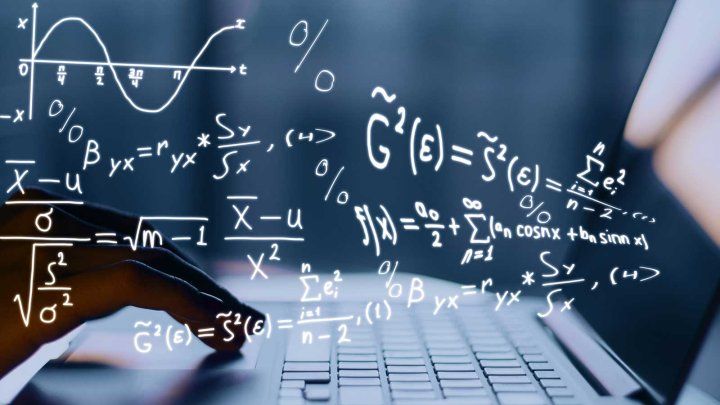Calculus, originally called infinitesimal calculus or the calculus of infinitesimals, is the mathematical study of continuous change, in the same way, that geometry is the study of shape and algebra is the study of generalizations of arithmetic operations.
Calculus has two major branches, differential calculus and integral calculus; the former concerns instantaneous rates of change, and the slopes of curves, while integral calculus concerns the accumulation of quantities and areas under or between curves.
These two branches are related to each other by the fundamental theorem of calculus. Both branches make use of the fundamental notions of convergence of infinite sequences and infinite series to a well-defined limit.

Who Invented Calculus?
The invention of calculus occurred in the latter half of the 1600s by two mathematicians, Gottfried Leibniz and Isaac Newton. Newton was the first of the two to develop calculus and apply it directly to studying physical systems.
Separately, Leibniz created the notations used in calculus. In short, while traditional math employs operations such as plus, minus, times, and division (+, -, x, and ÷), calculus uses operations that utilize functions and integrals to calculate rates of change.
Those tools allowed Newton, Leibniz, and other mathematicians who followed to calculate things like the exact slope of a curve at any point. The Story of Mathematics explains the importance of Newton's fundamental theorem of calculus:
"Unlike the static geometry of the Greeks, calculus allowed mathematicians and engineers to make sense of the motion and dynamic change in the changing world around us, such as the orbits of planets, the motion of fluids, etc."
Using calculus, scientists, astronomers, physicists, mathematicians, and chemists could now chart the orbit of the planets and stars, as well as the path of electrons and protons at the atomic level.
The two major concepts of calculus are:
- Derivatives
- Integrals
Basic Calculus
Basic calculus is the study of differentiation and integration. Both concepts are based on the idea of limits and functions. Some concepts, like continuity, exponents, are the foundation of advanced calculus. Basic calculus explains about the two different types of calculus called “Differential Calculus” and “Integral Calculus”. Differential Calculus helps to find the rate of change of a quantity, whereas integral calculus helps to find the quantity when the rate of change is known.
Calculus Topics
Differential Calculus Basics
It deals with variables such as x and y, functions f(x), and the corresponding changes in the variables x and y. The symbols dy and dx are called differentials. The process of finding the derivatives is called differentiation. The derivative of a function is represented by dy/dx or f’ (x). It means that the function is the derivative of y with respect to the variable x. Let us discuss some of the important topics covered in basic differential calculus.
Limits
The degree of closeness to any value or the approaching term. A limit is normally expressed using the limit formula as-
limx→cf(x)=A
It is read as “the limit of f of x as x approaches c equals A”.
Derivatives
Instantaneous rate of change of a quantity with respect to the other. The derivative of a function is represented as:
limx→hf(x+h)−f(x)h=A
Continuity
A function f(x) is said to be continuous at a particular point x = a, if the following three conditions are satisfied –
- f(a) is defined
- limx→af(x) exists
- limx→a−f(x)=limx→a+f(x)=f(a)
Continuity and Differentiability
A Function is always continuous if it is differentiable at any point, whereas the vice-versa condition is not always true.
Quotient Rule
The Quotient rule is a method for determining the derivative (differentiation) of a function that is in fractional form.
Chain Rule
The rule applied for finding the derivative of the composition of a function is basically known as the chain rule.
Integral Calculus Basics
Integral calculus is the study of integrals and their properties. It is mostly useful for the following two purposes:
- To calculate f from f’ (i.e. from its derivative). If a function f is differentiable in the interval of consideration, then f’ is defined in that interval.
- To calculate the area under a curve.
Integration
Integration is the reciprocal of differentiation. As differentiation can be understood as dividing a part into many small parts, integration can be said as a collection of small parts in order to form a whole. It is generally used for calculating areas.
Definite Integral
A definite integral has a specific boundary within which a function needs to be calculated. The lower limit and upper limit of the independent variable of a function are specified; its integration is described using definite integrals. A definite integral is denoted as:
∫abf(x).dx=F(x)
Indefinite Integral
An indefinite integral does not have a specific boundary, i.e. no upper and lower limit is defined. Thus the integration value is always accompanied by a constant value (C). It is denoted as:
∫f(x).dx=F(x)+C
You can use AllMath to solve problems related to derivatives, integrals, limits, and continuity.
This site offers various calculus tools that provide step-by-step solutions to complex calculus problems.
Practical Applications of Calculus
There are many practical applications for calculus in the real world. A few of the concepts that use calculus include motion, electricity, heat, light, harmonics, acoustics, and astronomy. However, calculus isn’t limited to these fields and is also used in geography, computer vision, photography, artificial intelligence, robotics, video games, and even movies. Additionally, calculus is helpful in calculating the rates of radioactive decay in chemistry and in predicting birth and death rates. Finally, calculus has a place in the study of gravity and planetary motion, fluid flow, ship design, geometric curves, and bridge engineering.
In physics, for example, calculus is used to help define, explain, and calculate motion, electricity, heat, light, harmonics, acoustics, astronomy, and dynamics. Einstein's theory of relativity relies on calculus, a field of mathematics that also helps economists predict how much profit a company or industry can make. And in shipbuilding, calculus has been used for many years to determine both the curve of the hull of the ship (using differential calculus), as well as the area under the hull (using integral calculus), and even the general design of ships.
In addition, calculus is used to check answers for different mathematical disciplines such as statistics, analytical geometry, and algebra.






